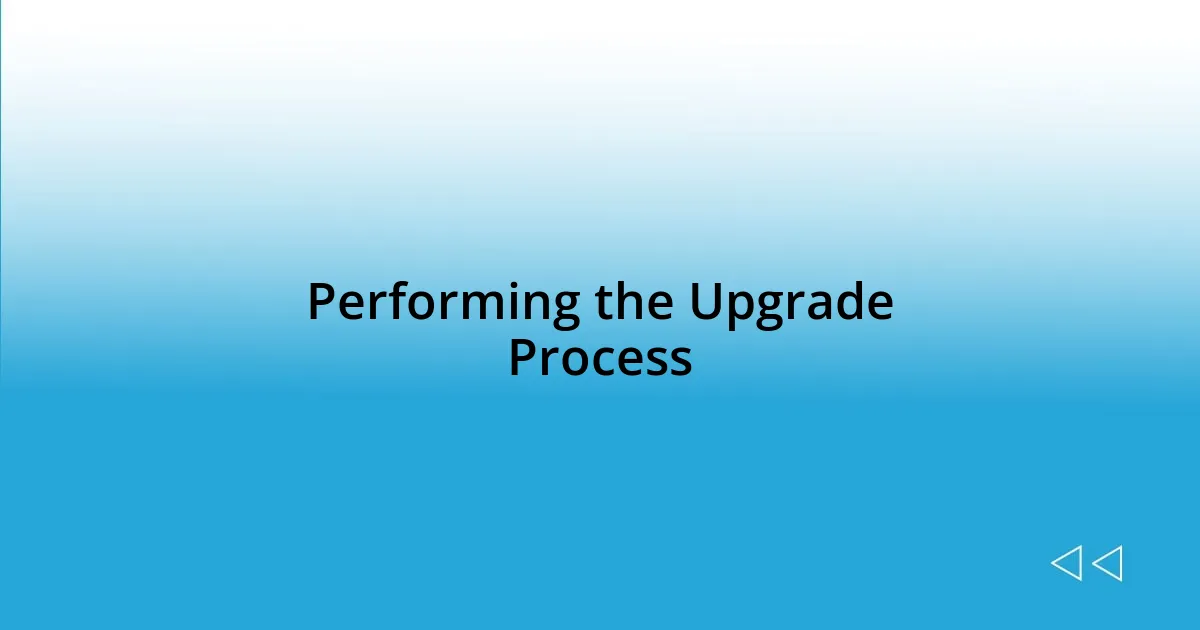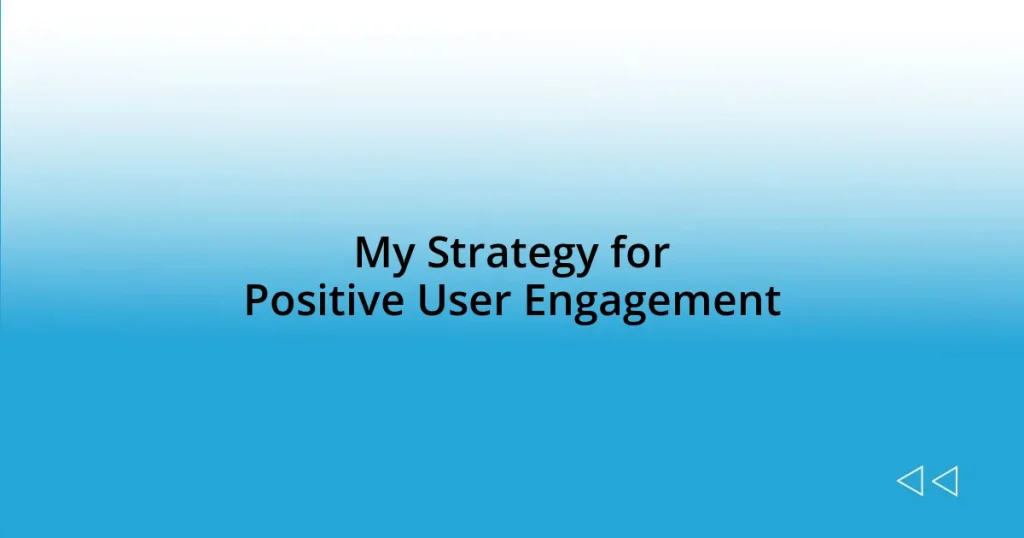Key takeaways:
- Identified performance issues, primarily due to limited RAM and a failing hard drive, prompting the decision to upgrade components.
- Conducted thorough research on suitable upgrades, emphasizing the importance of prioritizing RAM, SSD, and GPU for improved performance.
- Prepared meticulously for the upgrade by organizing tools, grounding oneself, and reviewing tutorials to avoid mistakes during installation.
- Performed testing on the upgraded system, confirming substantial performance gains and the necessity of a thorough evaluation post-upgrade.

Assessing My Laptop’s Performance
When I first noticed my laptop was lagging, I felt a wave of frustration wash over me. It was like my trusty companion was suddenly moving in slow motion, which raised a question: how was I supposed to keep up with my tasks at work? I decided to dive deeper into assessing its performance, checking the CPU usage and memory stats to understand where the bottlenecks were occurring.
Through this process, I discovered that my laptop’s limited RAM was often maxed out while running multiple applications. It felt like trying to juggle too many balls at once, and I realized that I needed a concrete solution. I vividly remember that moment when I closed a few tabs and took a deep breath, contemplating whether upgrading the RAM could bring my laptop back to life.
To get a better grasp of my laptop’s performance, I also turned to real-world scenarios. I started timing how long it took for applications to open and how smoothly they ran during heavy tasks like video editing. Watching the seconds tick away made my heart race. I couldn’t help but think: is my productivity worth sacrificing for outdated hardware? This self-assessment not only fueled my desire for an upgrade but made me appreciate the power of understanding my tech’s limitations.

Identifying Upgrade Opportunities
It’s crucial to pinpoint exactly where your laptop is struggling before diving into upgrades. For me, checking the hard drive’s health was an eye-opener. I distinctly recall the day I heard that ominous clicking noise while booting up; it felt like the laptop was whispering to me that it was time for an upgrade. After running a diagnostic check, I learned that my HDD was nearing failure; it was a wake-up call that forced me to consider switching to an SSD for faster load times and better reliability.
During my research, I also took a closer look at the graphics card capabilities. I remember getting lost in the immersive world of gaming and realizing how much graphical lag hindered the experience. That stutter made me question whether a dedicated graphics card would enhance not just my gaming sessions but also my work with graphic design software. The realization hit me: upgrading my GPU could elevate both leisure and productivity.
Now, let’s get to the crux of it—understanding what components to upgrade first. Based on my experience, prioritizing upgrades can save time and money. For instance, I learned that boosting my RAM had the most immediate impact on daily tasks, while the SSD upgrade dramatically improved boot times. Here’s a handy comparison of the areas you might consider upgrading:
| Component | Impact |
|---|---|
| RAM | Improves multitasking and performance in demanding applications |
| SSD | Enhances loading times and overall system responsiveness |
| GPU | Increases graphics quality for gaming and design work |
| CPU | Boosts processing speed, which is beneficial for heavy computational tasks |

Choosing the Right Components
Choosing the right components for my laptop upgrade felt like piecing together a puzzle. I spent hours researching the specifications and compatibility of each part. One particular evening, while scanning online reviews, I stumbled upon a community discussion about the benefits of RAM upgrades. I distinctly remember feeling a mix of excitement and anxiety as I read about how even an additional 8GB could transform my experience. It sparked a sense of hope that I could turn my frustrating struggles into a smoother, more efficient workflow.
As I narrowed down my choices, I created a checklist to help me stay focused:
- RAM: Opt for higher capacity to improve multitasking and enhance performance in applications.
- SSD: Choose a solid-state drive for quicker boot times; it’ll feel like you’re surfing on lightning.
- GPU: Look for a dedicated graphics card if you engage in gaming or professional design work to boost visual performance.
- CPU: If you work with demanding applications, consider upgrading your CPU for better processing speed.
Every decision felt personal, each component like a new character in my tech journey. My laptop was more than just a device; it was my partner in creativity and productivity. Choosing carefully meant I could revive our relationship.

Preparing for the Upgrade
Getting ready for an upgrade involves more than just ordering parts; it’s about setting the stage for success. I remember clearing off my workspace, making room for tools and components. It’s amazing how a tidy environment can change your mindset. I found even a little organization reduced my anxiety, allowing me to focus on the task without distractions.
Before I felt fully confident, I took inventory of my current setup. I opened up my laptop and made sure I had all the tools I would need—screwdrivers, thermal paste, and an anti-static wrist strap. I can’t stress enough how important grounding yourself is. I learned this the hard way when I accidentally zapped a component one time, turning my tech adventure into a tech disaster!
Part of preparing also includes reviewing the upgrade process. I spent time watching tutorials and reading guides, immersing myself in the knowledge. I still vividly recall one video I watched that highlighted the common pitfalls during installation. It made me wonder: What if I overlooked a tiny detail that could wreck everything? That fear turned into motivation, fueling my desire to approach the upgrade with care and precision.

Performing the Upgrade Process
When it came time to actually perform the upgrade, my heart raced with a blend of anticipation and nervous energy. With each screw I removed, I felt a mix of empowerment and vulnerability; after all, I was dismantling something that had been my trusted companion for years. I remember holding my breath as I swapped out the old hard drive for the new SSD, thinking, “Will this really make the difference everyone claims it will?”
As I connected each component, I couldn’t help but reflect on the journey that led me here. Trust me, taking that moment to appreciate the transition makes a significant difference. I often found myself pausing, checking and rechecking connections; it’s a bit like a surgeon performing a delicate operation. This cautious approach served me well. I once rushed through an upgrade early in my tech journey and ended up with an unresponsive laptop—never again!
Once everything was in place, I was ready for the moment of truth. I powered up my laptop, and as the screen lit up, I felt this surge of excitement—it was like opening a present on my birthday! Hearing that smooth boot-up sound was incredibly rewarding. I thought, “This is it. All the research, the late nights, and the adrenaline, they culminate in this one moment.” How exhilarating is it to witness the fruits of your own labor?

Testing the Upgraded Laptop
After completing the upgrade, I dove straight into testing my laptop to see if all that effort paid off. I remember feeling a nervous excitement as I opened my favorite resource-heavy software, waiting for signs of improvement. The moment it loaded in record time, I felt a rush of relief mixed with accomplishment—it was a clear indication that the SSD made a tangible difference.
I didn’t stop there; I decided to run a few benchmarks to get concrete data on performance gains. Seeing those numbers rise was electrifying! But then, a thought struck me: Are these gains sustainable? To put it to the test, I pushed the machine with several demanding applications running simultaneously. Watching it handle the workload without breaking a sweat made me proud. It was as if I had given my laptop a new lease on life.
Throughout this testing phase, I kept thinking about how critical this step is in the upgrade process. I recalled my first upgrade attempt when I skipped proper testing and ended up with frustrating slowdowns. Now, as I conducted stress tests and realistic use cases, I knew without a doubt that a thorough evaluation is essential. Did I mention how satisfying it is to monitor performance and see all those numbers reflect my effort? It felt like every minute I spent researching had crystallized into this triumphant moment.
















